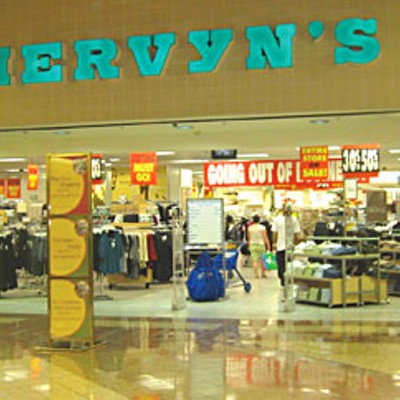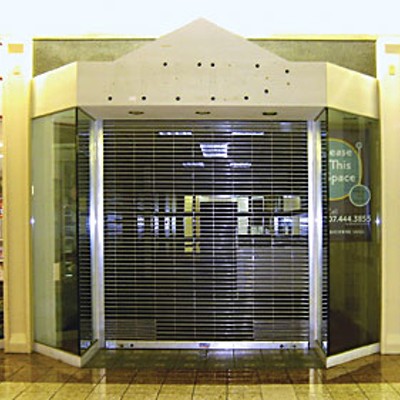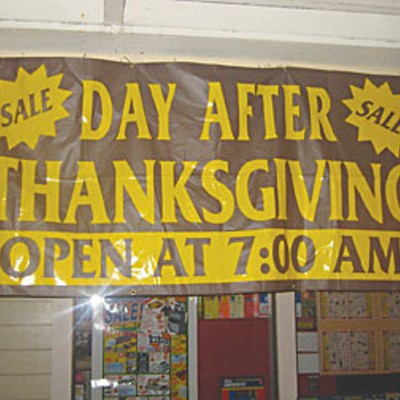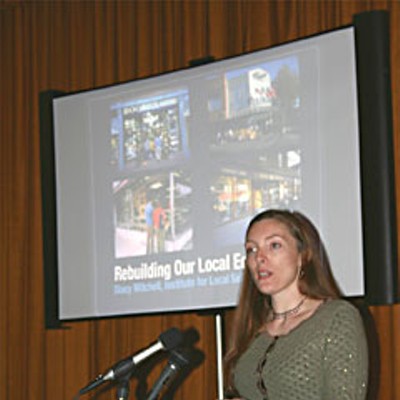They call it Black Friday. The day after Thanksgiving is one of the best days of the year for retail -- it's the day that heralds the start of the all-important holiday shopping season; only the Saturday before Christmas surpasses it in overall sales. Retailers everywhere are hoping you'll come to their business to find that perfect gift.
Expect Friday's newspaper to be chock-a-block with inserts from various chain stores enticing you with doorbuster sales and gift-giving ideas, pitches festooned with images of holly garlands, Christmas trees and wrapped presents.
But Black Friday also sounds kind of ominous, echoing Black Tuesday, the day the stock market crash ushered in the Great Depression -- still, the day is considered all-important for retailers, with some hoping they'll shift from operating in the red to the black.
Of course the push for holiday shopping is already underway. In mid-November Sears and K-Mart both advertised "Black Friday prices now!" Arcata Main Street's "Earlier than the Bird" promotion was last Saturday; Henderson Center brought Santa in for its holiday kick-off last Thursday. And yes, the Journal started its string of holiday gift guides last week.
Pretty much every local business organization is mounting its own campaign. The Arcata Chamber of Commerce asks you to "Shop Locally, Shop Arcata First." Fortuna and Eureka would also like to see you in their business districts.
In the midst of all this, a nascent group called the Humboldt County Independent Business Alliance is signing up members, pulling together a directory of locally-based businesses and asking people to pledge to conduct 25 to 100 percent of their shopping at locally owned and operated businesses. The organizers see chain stores, big boxes and corporate malls as a negative influence. They don't want more of them in the community and would like to see the existing ones go away.
The irony is, for the most part the big boys are already failing. After years of unrestrained growth, just about any major retailer you can name is in trouble -- with the notable exception of Wal-Mart.
Borders, the archenemy of every indie bookseller, put itself up for sale earlier this year. Sears and Kmart joined forces a few years back to protect themselves from Wal-Mart; they're still in trouble. Look at the stock price chart for Target, Gottschalks, Bed Bath and Beyond, and other chain retailers and you'll see they're all in deep downward slides.
While indie biz Davids are preparing for battle against corporate Goliaths, the giants are falling off an economic cliff.
Beneath the holiday cheer emanating from stores and business groups there's a hint of desperation. Face it: This shopping season comes in the midst of the worst financial slump in decades. With unemployment up, credit tight and financial markets reeling, retail is not doing well -- at all. According to U.S. Dept. of Commerce reports, October was the fourth month in a row with a decline in retail sales over last year. Sales at American chain stores are at their lowest levels in 35 years. Analysts are saying this could be the first holiday season in recent history when sales decline over last year.
Stores are closing up shop left and right. Locally we've seen The Gap, the Old Navy outlet, KB Toys and Wilson Leather among those who've departed from the Bayshore Mall as those chains retreated across the nation.
Mervyns, one of the mall's original anchor stores, is currently liquidating its inventory with a going-out-of-business sale. The parent corporation, once among the top regional retailers in the nation, filed for Chapter 7 bankruptcy in October. The Eureka location is just one of 149 remaining Mervyns in California and the Southwest using the holidays as a final close-out. The company closed 27 stores earlier this year. Altogether the chain will leave 13.66 million square feet of retail space vacant.
Meanwhile General Growth Properties Inc., the Chicago-based real estate investment company that owns the Bayshore Mall (and 219 others), is in serious financial trouble. The value of shares in GGP, the second largest mall owner in the United States, plunged recently following a Nov. 10, Securities and Exchange Commission filing in which they laid out the bad news: The company has $1.13 billion in debt coming due in the coming weeks including $900 million in mortgage debt on malls in Las Vegas due on Black Friday, and another $58 million in corporate debt due Dec. 1. An additional $3 billion-plus comes due next year.
The SEC filing reads in part, "In the event that we are unable to extend or refinance our debt or obtain additional capital on a timely basis and on acceptable terms, we will be required to take further steps ... including seeking legal protection from our creditors.
"Our potential inability to address our 2008 or 2009 debt maturities in a satisfactory fashion raises substantial doubts as to our ability to continue as a going concern."
Business bankruptcies? Credit squeeze? Financial meltdown? Local v. corporate? How much is all of that affecting Humboldt shoppers? Plenty. That's what we found when we asked an admittedly skewed sampling of potential consumers about their plans for holiday purchases. Will they be buying as much as usual between now and Christmas? Where will they shop, and why?
"Shopping to save the country and the world?" asked Jane Lapiner, a Petrolia back-to-the-lander who was in town for an artist reception, part of Arcata Main Street's monthly Arts! Arcata. Describing herself as "crafty," Lapiner said she'll be making holiday gifts herself.
"I shall shop resolutely and bravely," declared her friend Alexander Cockburn, a fellow Petrolian who is co-editor of the political newsletter Counterpunch.
Lapiner was not certain where she'll shop for various supplies for her gift projects. She said she tries to "shop local." One thing she's sure of: She won't be visiting the Bayshore Mall this holiday season. In fact, she's never been there. "I'm boycotting," she said proudly (eliciting mockery from Cockburn). She blames the mall for having a negative impact on Eureka's downtown, specifically for the closure of one of her old favorite stores, Bistrin's. "You're talking of the retail economy of the 1890s," Cockburn interjected. "It's gone."
Cockburn was the only person we spoke with who knew about General Growth Properties' financial straights. (Lapiner, who had never heard of General Growth, said it "sounds like a cancer.")
"It's the same as all the others," said Cockburn. "Circuit City's gone. Linen ’N Things, bankrupt. Borders, in trouble. They're all going bankrupt -- this is a depression. How long can you keep going when you can't sell anything? There's too much retail here -- it's overblown for the population and the money they have. How can you possibly keep all these stores going?"
Taffy Stockton, former director of Arcata Main Street, is another DIY present maker. She's planning on doing some sewing and will buy her supplies at "neighborhood" stores. "I believe in buying local, in supporting the local economy," she said. "When we keep our money in the community, it gets spent locally again and again, whereas if you take your business outside the community, it gets spent elsewhere." This became a familiar refrain.
Sierra-Rose Przybyla, a clerk at Belle Star and an HSU student, is yet another who will be making gifts and thus doing less shopping. "I just moved here so I've been exploring the shopping possibilities," she said. She's bought craft and sewing supplies in Arcata, but also shops at Michaels, the arts and crafts chain store at the Eureka Mall.
"I believe in shopping locally, that you vote with your dollar, but I'm also a student and I'm on a small income, and sometimes you have to balance your karma against your income, your paycheck," she said. Thus she occasionally shops at the mall and Target, where she noted, "They have basic things, and you know what you're getting. You can get things there that local shops don't carry, most likely because they're out-competed. It's unfortunate but it's true."
Asked if she was aware about GGM's potential bankruptcy, she admitted she was not, then asked, "Are they in line for a bailout?"
Outgoing Third District Supervisor John Woolley was at Garden Gate on the Plaza for Arts! Arcata watching his son play fiddle. He was philosophical about the coming shopping season. "We have to shop for each other right now because the world is falling apart. We have to keep buying little things. I love shopping in Arcata because it represents the world in my own little microcosm. Of course I have to go to the mall now and then. I think there's still a need for it, until we can figure out a place to get cheap underwear."
Eureka City Councilman Larry Glass has a long history in local independent business. He established his first record store in Eureka in 1971. Today he has two locations for The Works, one in Arcata, another in Eureka's Old Town. Taking a break from the store, he sat down with an oversized cup of tea at Old Town Coffee and Chocolates to discuss commerce, beginning with his own variation on the "buy local" mantra.
"I buy products from out of the area to sell, but all the profit stays here because the money's paid to my employees, to vendors around here, rent to my landlord, all of that stays here. But with these corporations that come to town, very little of the money stays here."
The dollar loss reminds him of Ross Perot's famous "giant sucking sound" quote about NAFTA. "I can almost hear that sound when I look at the Bayshore Mall and all those corporate stores skimming the cream off the top around here. That money doesn't stay here, it's gone."
By the time the Bayshore Mall was built in 1987, Glass had moved his business to Old Town. Even before the mall opened, Glass and others had banded together to form the Eureka Business Improvement District, which eventually morphed into Eureka Main Street.
Back then the city of Eureka was pumping money into revitalization of the downtown corridor and Old Town, putting in brick walkways and building the Gazebo, but stiff competition from the new mall proved too much for many small businesses.
"Within a five-year period something like 90 percent of the businesses around me went under," said Glass. "We saw it coming. It gradually came back to life, but in a different form: very mom-and-pop, mostly businesses with just a few employees."
While waiting impatiently for the EIR on the Marina Center project proposal and wondering how much retail the final iteration will include, Glass has been keeping an eye on what's happening with General Growth.
"If they go out of business, does that mean they'd sell that mall?" he wondered aloud. "Does that mean Wal-Mart steps in and buys the mall and levels it to put Wal-Mart there, like they've been dying to do for so long? The city would have nothing to say about that. An already existing shopping center would require nothing permit-wise to the best of my knowledge. They could do whatever they want to do."
That scenario obviously alarms him, and he's concerned about the potential impact of new big boxes on the waterfront, but right now, like all merchants, he's wondering how many customers he'll see in the weeks ahead.
"Everybody's hurting. It's tough. People are losing jobs. People are losing their houses. And the worst part of it is, people are losing hope.
"We've been through hard times in this county before, but I've never seen so many people lose hope like this. I'm still hopeful. My business has been hit, but when times get dark, people need music to get by. I think we'll survive."
The Bayshore Mall opens early Black Friday, really early — 6 a.m. to be exact. Santa will arrive at some point and set up shop for photo ops. There will be discounts galore. In some stores the holiday sales began last weekend.
Bayshore Mall property manager Sue Swanson isn't surprised that the sales have already started. "I think retailers are hoping if they start discounts early it will help them -- and the consumer," she said, pointing out that Thanksgiving came late this year. "Between the national economy, which of course we feel here too, and the fact that there's a compressed shopping season, a lot of retailers have started discounting early."
The good news: sales, sales, sales. The bad news: People have less money to spend at those sales.
"We're not immune to layoffs and the way the economy is going," said Swanson. "And I'm sure our retirement community is feeling the effects of the stock market like everyone else. We all have to take pause. Even if you have a job, you're looking at your budget and you may not spend money like you did in the past."
All things considered, Swanson feels things are going well at the mall. Some tenants are doing better than others, but she says weekends, the mall's big days, there are plenty of shoppers.
"There are some empty storefronts. For some stores it's not that they didn't do well here -- like, Mervyns did well here -- but the company as a whole didn't do well. We've been hit by that cycle on many fronts."
She says the departures of The Gap and Old Navy, both part of a "struggling corporation," were primarily based on demographics. The stores simply found they could not achieve the sales per square foot ratio they were hoping for.
"When their lease came up they didn't renew because this is not considered an 'A' mall, like Stonestown in San Francisco for example. We're a 'C', a community mall, and a lot of us live here because we don't want to live someplace with the kind of population base that serves an 'A.'"
One thing Bayshore Mall has going for it is the fact that, even though its an old mall by national standards, no other comparable malls have been built anywhere in the county, so the service area is wider. People drive a long way to shop there.
"Borders, Bed Bath and Beyond and Petco all do really well here," said Swanson. "When you're a big company, and you've put in all your A stores and B stores, you look at communities like this one."
She's not too concerned about the pending departure of Mervyns. While it won't happen overnight, the search for a new anchor is underway. "There's a lot of interest in that space," she said. "The retail community knows that Mervyns did solid numbers. Others would like to do the same. They know the money's here, if you have the right products and you're the right retailer."
Swanson is trying to remain positive about General Growth's situation. She figures the company's assets will carry it through these days of tight money. The firm owns 220 malls including "some stellar properties," and she doesn't think it will go under. "This is a hiccup that was unforeseen. I feel strongly we'll weather it fine," she said.
She admitted she is a bit worried about her GGP stock. Shares were selling for 40 cents the day we spoke, down 99 percent in the last year. GGP is definitely not in the clear yet. According to a report in the Wall Street Journal last week, the company is trying to sell three luxury malls in Vegas and is working with Goldman Sachs, Morgan Stanley and Deutsche Bank on financial restructuring, including a request to extend the deadline on the $900 million due on Nov. 28. WSJ also noted that GGP has hired a bankruptcy law firm. If the company ultimately files for protection, it would be the biggest real estate failure in recent memory.
In an official statement, David Keating, GGP Director of Corporate Communications, was as upbeat as Swanson: "Regardless of our situation, our properties and company will continue to operate, remain vibrant and look forward to a prosperous holiday season."
On a Monday morning, Jennifer Koopman, executive director of Arcata Main Street, sat ensconced behind her big black desk in the nonprofit's office in the Jacoby Storehouse talking on the phone. Discussing Main Street's "Earlier than the Bird" pre-Thanksgiving promotion with a member, she talked of "keeping the dollars here."
"What we're trying to do is promote getting people into downtown to shop, to put their dollars back into the local community," she explained a few minutes later. She figures that's part of Main Street's mission, along with "promoting and enhancing Arcata's identity, economy and cultural spirit."
Koopman said all the retailers she's talked with have high hopes for holiday business, but many are worried about how much financial gloom will filter down to the local level.
"Numbers are down for Arcata businesses, but we're not seeing people going out of business left and right. We lost The Metro, but now Solutions has moved into that spot [on the Arcata Plaza]. It's not as bad as what I've heard on a national level, but people are telling me they're down 30 percent from previous years."
In response, both Arcata Main Street and the Arcata Chamber of Commerce are promoting "shop local" campaigns.
"I just hope people are aware how much their decision on where to shop affects the community," said Koopman. "There are so many reasons to shop local. We're not always the cheapest place to shop, but we have higher quality goods and better customer service. You don't have to drive so far, which reduces your gas cost. And the money you spend locally goes back into the local economy, which creates more jobs and in turn more people are spending money. It's a cycle, a good one."
Koopman then trotted out some well-circulated stats: "If you spend $100 locally, $68 of that goes back into the local community, whereas if you spend that money at Wal-Mart or some place like that, it's $43," and the other 25 bucks goes elsewhere.
Those same oft-quoted figures, from a study done in the Andersonville neighborhood on Chicago's north side, cropped up at a talk last Tuesday by author/activist Stacy Mitchell. Local business owners, progressives and politicians (a few councilmembers and a couple of supervisors-elect) gathered at the Eureka Women's Club last week to hear Mitchell discuss "Promoting Our Local Options: Strategies for a strong local economy." Those assembled were not necessarily thinking about the holidays.
Mitchell, author of Big Box Swindle and The Hometown Advantage, is a senior researcher with something called The New Rules Project (named before comedian Bill Maher started using the term). The subtitles of her two books give an outline of her talk that night. Big-Box Swindle takes on "The True Cost of Mega-Retailers and the Fight for America's Independent Businesses." Hometown Advantage offers advice on "How to Defend Your Main Street Against Chain Stores and Why it Matters."
Mitchell also serves as board chair of the American Independent Business Alliance, comprised of 50 regional alliances including the relatively new Humboldt County Independent Business Alliance.
Indie business alliances serve several functions. One is educational. They let people know about the value of community-based businesses economically, culturally and socially so that, as IBA puts it, "residents view themselves as citizens, rather than as consumers," citizens who make conscious choices about where and how they spend their money.
In some cases the IBA takes on group promotion and even branding, leveraging members' numbers to get deals closer to what chain businesses can demand because of their size. And last, through strength in numbers, the IBAs "give a voice to the locally-owned independent business community and promote policy that supports community-rooted enterprise."
Mitchell laid out some cold hard facts about the state of retail Tuesday. In an earlier conversation, from her home office in Portland, Maine, she touched on the trouble with those "mega-retailers."
"Just look at the growth of large retail chains and how much they've come to dominate the market, and how many independent businesses we've lost nationally," said Mitchell. "I think people are waking up to the fact that there's a real high cost for that and that the benefits of the big box model are not what they appear to be. In fact there are all these hidden costs."
The folks whose indie businesses have survived are well aware of the impact of chains and big boxes, but it isn't always easy for them to get their voices heard, or to band together for that matter. As Mitchell noted, "The thing about independent businesses is, they're very independent. The people who run them like working for themselves. But they've realized more and more that their survival depends on building alliances with one another, that they're really interdependent."
Thus the need for organizations like the Humboldt County Independent Business Alliance (HumIBA for short).
Scott Menzies, a grad student at HSU, and Kaitlin Sopoci-Belknap of Democracy Unlimited of Humboldt County started the local alliance earlier this year. So far they've gathered around 70 members and listings for close to 500 local indie businesses for the upcoming Local Options Directory, something like a phone book for qualifying businesses.
In HumIBA terms an independent business is one that's privately-, employee-, community- or cooperatively-owned by local residents, with decisions about the business made in the county.
"It's about local control, keeping money in our local economy, building our community," said Menzies in a conversation at DUHC headquarters. "The antithesis would be a national chain with a large scale corporate structure behind it, a business where a lot of the services are in-house. Independent businesses tend to use other independent businesses in the area."
That interdependence dance is just what Mitchell says IBAs are all about.
"We'd like to see a stronger connection between the independent business owners and the community so that we maintain a diverse, vibrant, viable economy that can take hits better," Menzies continued. "If we're re-localized, if we've plugged our leakages, if we're keeping our money in our economy here, we're not going to be subject to problems happening on the outside as much. That's something we want to maintain."
The way Menzies sees it, Humboldt is not doing so bad now. "We already have a lot of independent business diversity; we have a lot of artisans producing local products. We're not in the same boat as some communities who have to create that. We just can't take it for granted and let it disappear. We have to preserve our independence."
Does shopping local and patronizing independent businesses make you a better citizen or us all more independent? We think so. As you may have read in last week's gift guide, the Journal has signed on to the Association of Alternative Weeklies' "Shop Local and Indie" campaign. It's easy: Just spend at least $100 of your holiday money at locally owned stores. Do it on Black Friday or whenever. Don't have a hundred bucks? "A ha'penny will do."
Without doing the math again (Journal publisher Judy Hodgson laid out the figures last week), we'll promise you, it will help the local economy. Think of it as a gift for your entire community. Okay, ready? Get out there and shop.










Comments (6)
Showing 1-6 of 6